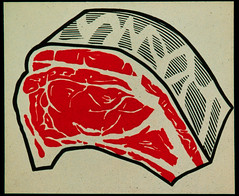January 13th
I tend to get a little obsessive about certain foods, especially when I’m learning how to make something and haven’t mastered it. As a result, it should come as little surprise that I tried to do more Ethiopian food again because I just can’t get the injera correct. The original recipe I tried called for using buckwheat and wheat flour saying that the buckwheat was a decent stand in for teff, but it didn’t cut it and the breads were also too thick. The last two times I tired 75% wheat flour and 25% teff but the batter was very thin and a little tough to work with. I’m waiting for a book on Ethiopian food from the library but did some research on the internet and did find some interesting recipes and resources (including a series of videos on Youtube) and worked a method based upon that.
Injera is a sour dough bread and there’s really no way to duplicate that if you don’t do a sour dough starter. Luckily, I kept a small amount of the last batch I had done about three days ago and let it sit on the counter where it got sufficiently sour. I fed this with some wheat flour and water to increase the size. I did stick to pretty close to a ratio of 75% wheat and 25% teff, because that seemed to give the right flavor before and the teff that I have is whole and needs to be ground which is kind of a pain. I let the dough sit until it was bubbly. I made the dough slightly thicker this time so it was somewhere between crepe and pancake batter. But the real key was reading the directions a little closer in some of the recipes. Injera is always cooked covered, which I had been doing, but it’s not flipped, which I just kind of assumed it was (most pan cooked flat breads, like tortillas and chapattis are flipped). Flipping them had been the issue but if they’re not flipped it’s easy (and has the right texture). It was kind of an embarrassing thing to realize, but it made sense when you think about the texture of proper injera.
This batch turned out fine, but you really need to take care when they’re cooling because they stick to things like plates really easily. If you rest them on a clean towel and move them every 20-30 seconds until they’re cool, they tend to stick less.
I did more chicken wat, but didn’t use a specific recipe as a guideline and just worked with spices that I had seen in other recipes. The sauce was pretty close to the Beef Wat from a few weeks ago and consisted of onions, tomatoes, berbere, ginger, garlic, cardamom and cinnamon. I did more red lentils and also had braised collard greens which were good but had too much ginger, which kind of overwhelmed them. But it was nice knowing that I had kind of mastered a passable injera recipe. I was also smart enough to keep some of the batter in the fridge as a sour starter for next time.
I like malty beers and spicy food and was happy with a few things that I picked up at a local store. The Widmer 08 Brewmaster’s Reserve Crimson Wheat is a lovely beer. Hops are in short supply this year and Widmer cleverly released a lower hopped beer with a great malt backbone and a subtle hop spiciness. It’s another great beer in their Brewmaster’s series and very different from most other beers out there. On their web site they say it goes well with burgers and sandwiches, but it’s malty profile makes it a winner with spicy food as well. I only bought the one bottle but will definitely be buying more. I also like the fact that it’s only 4.1% alcohol so you can actually drink a few of them. I also tried the Anchor Bock which was also a lovely beer. It’s darker than a lot of bocks, but still malty with good body. I preferred the Widmer with the food, but I wouldn’t turn the Anchor down.
While cooking I also tried a Baltika 9 Extra Lager. I like Baltika’s beer but have mostly had their porters. The Baltika 9 is a golden lager at about 8% alcohol. It’s not heavily hopped so there’s a fair amount of malt sweetness to it. It’s not as rich as a Maibock, and seems to fall halfway between malt liquor and maibock. It’s an interesting beer, but a little heady on its own. It’s probably better with food, so I may need to try it that way n the future.
Thursday, January 17, 2008
January 13th
Subscribe to:
Post Comments (Atom)

No comments:
Post a Comment